In the ever-evolving world of textile printing, Direct to Film (DTF) printing has emerged as a groundbreaking technology, offering unparalleled flexibility, quality, and efficiency. At the heart of this revolution are the DTF printing material manufacturers, whose innovative products are setting new standards in the industry. This article delves into the transformative impact of DTF printing, the role of material manufacturers, and the future prospects of this technology.
The Advent of DTF Printing
Direct to Film printing, a relatively new technique, involves printing designs onto a special film, which is then transferred onto fabric through a heat press process. This method stands out for its ability to print on a wide range of fabrics, including those difficult to print on with traditional methods. DTF printing has quickly gained popularity for its versatility, vibrant colors, and durability of prints.
The Role of Material Manufacturers
The success of DTF printing relies heavily on the quality of materials used, which includes the printing film, inks, and powder adhesives. DTF material manufacturers are at the forefront of research and development, constantly striving to enhance the quality and efficiency of these materials. Their efforts have led to significant advancements, such as faster drying inks, more durable films, and eco-friendly options.
Innovations in Materials
Innovation by DTF material manufacturers has been key in overcoming the initial challenges faced by the technology. Early issues such as ink smudging, film peeling, and limited fabric compatibility have been addressed through the development of advanced inks, high-quality films, and versatile adhesives. These innovations have not only improved the print quality but also expanded the range of fabrics that can be printed on, opening up new avenues for designers and textile producers.
Sustainability Focus
Sustainability is becoming increasingly important in the textile industry, and DTF printing material manufacturers are leading the charge in this area. By developing eco-friendly inks and recyclable films, they are reducing the environmental impact of textile printing. These sustainable materials offer a compelling alternative to traditional printing methods, which often involve toxic chemicals and produce significant waste.
Challenges and Solutions
Despite its many advantages, DTF printing faces challenges, such as the high initial investment in equipment and the need for skilled operators. However, manufacturers are addressing these issues by offering more affordable and user-friendly printing solutions. Training programs and technical support services are also becoming more widely available, making it easier for businesses to adopt DTF printing.
The Future of DTF Printing
The future of DTF printing looks promising, with ongoing advancements in technology and materials. Manufacturers are exploring new frontiers, such as 3D printing effects and increased automation, to further enhance the capabilities of DTF printing. As these developments unfold, DTF printing is set to become even more versatile, efficient, and accessible.
Conclusion
DTF printing material manufacturers are playing a pivotal role in the textile printing revolution. Through their commitment to innovation and sustainability, they are not only improving the quality and efficiency of DTF printing but also contributing to a more sustainable textile industry. As the technology continues to evolve, the collaboration between manufacturers, designers, and textile producers will be crucial in realizing the full potential of DTF printing. The journey of DTF printing, from a novel idea to a key player in textile printing, exemplifies how innovation can drive industry-wide transformation.



